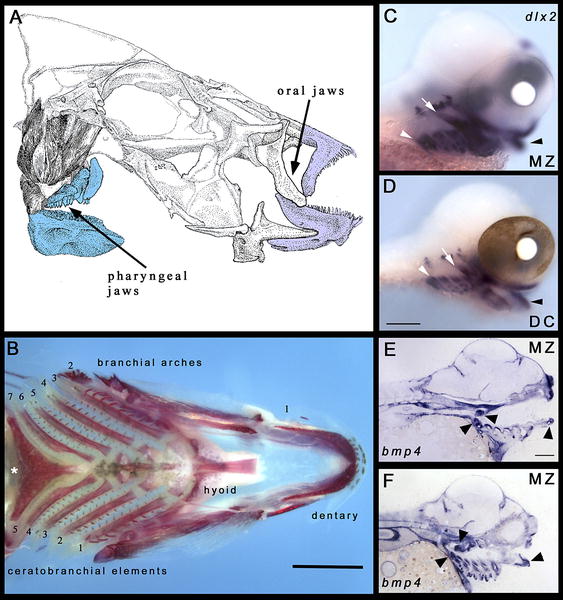The first vertebrates to have teeth were a group of eel-like jawless fish known as the conodonts that had teeth not in their mouth, but lining the throat. This particular group is long since extinct, but some modern fish retain teeth in the throat (pharynx). Gareth Fraser, postdoctoral fellow at Georgia Tech's School of Biology, and colleagues studied tooth formation in a group of fish known for their rapid rate of evolution, the cichlids of Africa's Lake Malawi. The cichlids have teeth both in their oral jaws, like humans, and deep in their throats on a pharyngeal jaw. Darrin Hulsey first identified a surprising positive correlation between the number of teeth in the oral jaw and in the throat in these fish.
"It's likely that every tooth made throughout the evolution of vertebrates has used this core set of genes," said Fraser. "Originally, I thought there wouldn't be a correlation due to the developmental differences and the evolutionary distinction between the two jaw regions, but it turns out there is. So fish that have fewer oral teeth also have fewer pharyngeal teeth. This shows that on some level there's a genetic control that governs the number of teeth in both regions."

Malawi Cichlids Exhibit Toothed Oral and Pharyngeal Jaws. (A) Schematic drawing (lateral view) of the generalized cichlid cranial skeleton, showing the relative location of the oral jaws (purple) and the pharyngeal jaws of PA7 (blue). (B) Dorsal view of an alizarin red skeletal preparation of the lower pharyngeal and oral elements of a juvenile D. compressiceps (DC) showing the series of branchial (pharyngeal) arches 1–7 and ceratobrachial elements CB1–5; the white asterisk indicates the toothed pharyngeal jaw. Scale bar represents 500 μm. (C and D) Lateral views with expression of dlx2 labeling neural crest-derived cells in the pharyngeal arches of M. zebra [MZ] (C) and D. compressiceps [DC] (D). Both cichlids are 4 dpf and to the same scale; scale bar in (D) represents 200 μm. dlx2 expression is observed throughout the arches from the mandibular arch, PA1 (black arrowheads), throughout the pharynx to the most posterior arch, PA7 (white arrowheads). dlx2 expression is also present in neural crest-derived mesenchymal cells that populate the arches (white arrows). (E and F) Sagittal sections of MZ (5 dpf) showing expression of bmp4 in multiple regions of the developing head and pharynx. bmp4 is expressed throughout the arches in neural crest-derived arch mesenchyme for each pharyngeal arch (PA1–7), including both the mesenchyme and epithelial components of the developing teeth (black arrowheads). (E) The medial sagittal section and (F) lateral sagittal section show the gill-bearing arches (PA3–6). Both (E and F) are to the same scale; scale bar in (E) represents 200 μm. From: An Ancient Gene Network Is Co-opted for Teeth on Old and New Jaws Fraser GJ, Hulsey CD, Bloomquist RF, Uyesugi K, Manley NR, et al. PLoS Biology Vol. 7, No. 2, e31 doi:10.1371/journal.pbio.1000031
The team investigated what this control might be by using a technique localizing gene expression in the cells during tooth development, known as in situ hybridization, and found that a common genetic network governs teeth in the two locations.
"So seemingly, regardless of where you grow a tooth, whether it's in the jaw or the pharynx, you use the same core set of genes to do it," said co-author J. Todd Streelman. "We also think it's probable that this network is not just acting in teeth, but also in other similarly patterned structures like hair and feathers."
Citation: Fraser GJ, Hulsey CD, Bloomquist RF, Uyesugi K, Manley NR, et al. (2009) An Ancient Gene Network Is Co-opted for Teeth on Old and New Jaws. PLoS Biol 7(2): e1000031 doi:10.1371/journal.pbio.1000031






Comments